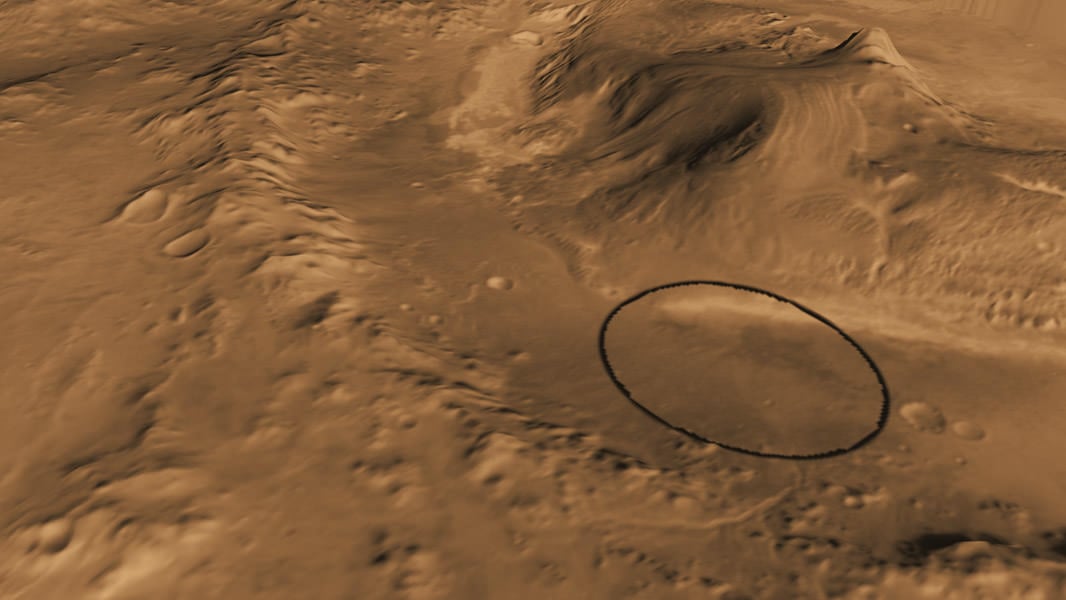[/caption]
It's official: the Mars Science Laboratory rover, Curiosity, will be landing Gale Crater on Mars. Scientists announced the final decision at a special event at the Smithsonian's National Air and Space Museum Friday morning. Comparing the terrain to an enticing bowl of layered Neopolitan ice cream, the science team announced the rover will land at the foot of a layered mountain inside Gale Crater.
"The science at Gale is going to be amazing and it will be a beautiful place to visit," said Dawn Sumner, a geologist with the MSL team.
MSL is scheduled to launch in November 2011 from NASA's Kennedy Space Center in Florida and land in August 2012. Curiosity is twice as long and more than five times as heavy as previous the Mars Exploration rovers Spirit and Opportunity. The rover will study whether the landing region at Gale crater had favorable environmental conditions for supporting microbial life and for preserving clues about whether life ever existed.
News had leaked out a few weeks ago that Gale was the favored site, but scientists today explained what made Gale stand out among the four final candidates, which each offered their own delicious "flavor," making the decision a difficult one.
[caption id="attachment_87678" align="aligncenter" width="580" caption="NASA has selected Gale crater as the landing site for the Mars Science Laboratory mission. Image Credit: NASA/JPL-Caltech/ASU"]
[/caption]
"When it comes down to four landing sites, it comes down to what feels right," said John Grotzinger, Mars Science Laboratory project scientist. "We as a science team, as a community, we got together and in the end we picked the one that felt best. Why? Here, we've got mountain of rocks, taller than Mount Whitney. It looks like Hawaii; it's not a tall spire, but a broad mound. So we can actually climb up this mountain with the rover. That alone justifies sending the spacecraft there. It turns out, though, the most attractive science sites are at the base of the mountain. We can address the principle goals of the things the Mars community would like answers to."
NASA's strategy for Mars has been to "follow the water," since we know that wherever there is water on Earth, there is life. Scientists are hedging their bets on Mars that wherever liquid water once flowed would be the best places to look for evidence of past habitability.
Gale has that going for it.
[caption id="attachment_87055" align="aligncenter" width="552" caption="Gale Crater stratigraphy. Iimage courtesy Matt Golombek. "]
[/caption]
The portion of the crater where Curiosity will land has an alluvial fan likely formed by water-carried sediments. The layers at the base of the mountain contain clays and sulfates, both known to form in water.
"It's a huge crater sitting in a very low-elevation position on Mars, and we all know that water runs downhill," Grotzinger said. "In terms of the total vertical profile exposed and the low elevation, Gale offers attractions similar to Mars' famous Valles Marineris, the largest canyon in the solar system."
The scientists emphasized that MSL is not a life detection mission, as it can't look for fossils. But it can detect organic carbon, which can tell the early environmental story of Mars, found in the sediments within rocks.
Gale Crater crater spans 154 kilometers (96 miles) in diameter and is about the combined area of Connecticut and Rhode Island. The mound in the center rises 5 km (3 miles) height and the Layering in the mound suggests it is the surviving remnant of an extensive sequence of deposits.
The crater is named for Australian astronomer Walter F. Gale.
About the size of a Mini-Cooper, Curiosity has 17 cameras and a full color video camera. The mission should offer incredible vistas that will likely wow the public, beginning with the landing, as Curiosity will take a full color, high definition movie as it descends on the "Sky Crane" landing system.
Anyone else ready for this mission to get going?
 Universe Today
Universe Today
